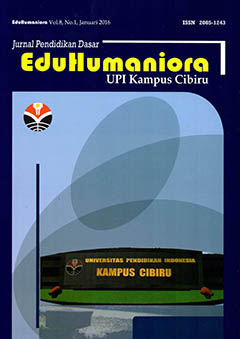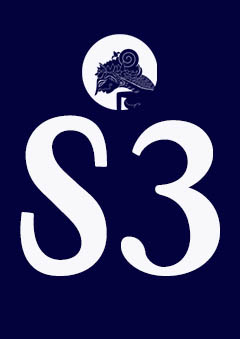Media Komik Pada Pelajaran IPA Untuk Meningkatkan Multiple Intelligences Siswa SD
Abstract
Abstract
This study was grounded on the students’ hobby in reading comics. The result of the literature study showed that comic used as media in learning Physics was very effective as learning media and attractive to be read. One of the supporting factors of this success in improving the students’ multiple intelligences was the integration of art and craft activities in the science learning process. Moreover, the theory of multiple intelligences accomodated students with various way of learning thinking. The developed training model in this study consisted of five stages that were orientation, presentation, structured excersice, guided excersice and individual excersice. In each Science class, the learning process was always started with the elicitation of students’ prior knowledge. Then each student got one comic to be read. After the reading session, the teacher asked them about the contents of the comics either classically or individually. In the next step the students were invited to observe the demonstration done by the teacher only if the instruments or materials were not safe for them, (e.g hot water). Nevertheless, if they were safe enough for the students, they were allowed to do the experiment by themselves. Students’ worksheets (LKS) were done by the students in group to develop their interpersonal and verbal-linguistic intelligences. Based on observation during experiments and drawing activities, the students’ visual-spatial intelligences were developed. Every learning process was always ended with knowledge test individually which would be discussed later. The study concluded that: 1) the training model improved PGSD students’ skills in developing comic as teaching media, 2) comics are proven to improve the elementary school students’ motivation in learning science, 3) comic enhanced elementary school students’ understanding in science knowledge which was indicated by the achievement of the students’ test score (85 point grade). Comic also developed elementary school students’ multiple intelligences in the aspects of verbal-linguistic, logical-mathematic, visual-spatial, naturalist, and interpersonal. It is recommended that comic should be developed as teaching media especially in elementary school. Comis can be used as one alternative of learning medias that can motivate students to learn something as well as improving their reading hobby. Key Word: comic, motivation, learning science, achievement
Full Text:
PDF (Bahasa Indonesia)References
DAFTAR PUSTAKA
Abidin, Y. (2009). Guru dan Pembelajaran Bermutu. Bandung: Rizqi Press
Badan Standarisasi Nasional Pendidikan. (2006). Pedoman Penyusunan
Kurikulum Tingkat Satuan Pendidikan. Jakarta: Balitbang Depdiknas
Cameron, L. (2001). Teaching Languages to Young Learners. Cambridge:
Cambridge University Press
Campbell, L. & Dickinson, D. (1996). Teaching and Learning Through Multiple Intelligences. USA: Allyn and Bacon
Departemen Pendidikan Nasional. (2003). Undang-undang RI no. 20 tentang Sistem Pendidikan Nasional
E. Mol, S. et.al. (2009). Interactive Book Reading in Early Education: A Tool
to Stimulate Print Knowledge as Well as Oral Language. Dalam Review
of Educational Research [online], Vol 79, (2), pp. 979-1007. Tersedia:
http://rer.sagepub.com/cgi/content/abstract/79/2/979 [9 Maret 2009]
Gega, P,C. (1982). Science In Elementary Education. New York : John Wiley and
Sons
Hammond, L, D. (2006). Powerful Teacher Education. San Fransisco: John Wiley
& Sons, Inc
Karli, H & Yuliariatiningsih, M.S. (2004). Implementasi Kurikulum Berbasis
Kompetensi Model-Model Belajar. Bandung : Bina Media Informasi
Muslim, A. (2009). Pengaruh Motivasi Belajar Terhadap Hasil Belajar IPA
Siswa Kelas V Sekolah Dasar di Kecamatan Balubur Limbangan. Skripsi
Universitas Pendidikan Indonesia: tidak diterbitkan
N’ Namdi K. (2005). Guide to Teaching Reading at the Primary School Level.
UNESCO
Nugraha, I,S,E. (2009). Penggunaan Media Komik untuk Meningkatkan Motivasi
Belajar Siswa pada Pembelajaran IPA Konsep Pesawat Sederhana. Skripsi Universitas Pendidikan Indonesia: tidak diterbitkan
Pranata, M. (2003). Ceramah Desain Berbasis Keterampilan Visual. Jakarta : Gramedia
Prindani, W. (2009). Uji Coba Komik Fisika Berjudul Bunyi Karya Istianah Qudsi
FT sebagai Media Pembelajaran IPA SMP Kelas VIII. Skripsi, Jurusan
Pendidikan Fisika FMIPA Universitas Negeri Malang: tidak diterbitkan
Read, C. (2005). “Managing Children Positively”. Journal of English Teaching Professional. 38, 4-7.
Renner, J. W & Stafford, Don. G. (1979). Teaching Science in in The Elementary School. New York : Harper & Row Publishers
Sanjaya, W. (2007). Kajian Kurikulum dan Pembelajaran. Bandung: tidak
diterbitkan
Sanjaya, W. (2008). Kurikulum dan Pembelajaran. Jakarta: Kencana Prenada Media Group
Santrock, J.W. (2008). Life Span Development. USA : Mc Graw Hill Inc
Smith, M, K. (2008). Howard Gardner and Multiple Intelligences, The
Encyclopedia of Informal Education. [online].
http://.www.infed.org/thinkers/gardner.htm
Sumaji, et al. (1996). Pendidikan Sains yang Humanistis. Yogyakarta: Penerbit Kanisius
Tanner, R. (2001). “Teaching Intelligently”. Journal of English Teaching
Professional. 20, 40-41.
Tanner, R & Green. C (1998). Tasks for Teacher Education. New York:
Longman
Tanpa nama (2008), Pengembangan Media Pembelajaran. [online]
www.eduarticle.ahmadhidayat.blogspot.com
Tanpa nama (tanpa tahun). Theory of Multiple Intelligences. [online].
http://www.en.wikipedia.org/wiki/Theory_of_multiple_intelligences.htm
Yanthi, N. (2009). Pembelajaran IPA Secara Dwibahasa Melalui Metode
Bercerita untuk Meningkatkan Multiple Intelligences Siswa SD
Laboratorium UPI Kampus Cibiru. Jurnal Edu-Humaniora UPI Kampus
Cibiru: UPI Press
Yuliariatiningsih, M, S. (2009). Model Direct Training untuk Meningkatkan
Keterampilan Mahasiswa PGSD Cibiru Membelajarkan IPA SD dalam
Bahasa Inggris. Jurnal Edu-Humaniora UPI Kampus Cibiru: UPI Press
Wright, A. (2001). Art and Crafts with Children. Oxford: Oxford University Press
DOI: https://doi.org/10.17509/eh.v2i2.2769
Refbacks
- There are currently no refbacks.
Copyright (c) 2016 Kampus Cibiru 2016
EduHumaniora: Jurnal Pendidikan Dasar
Published in collaboration Program Studi PGSD UPI Kampus Cibiru
and
HDPGSDI
This work is licensed under a Creative Commons Attribution-ShareAlike 4.0 International License.















